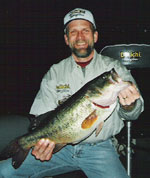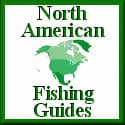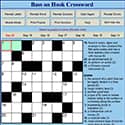Bass on Hook is Supported by our readers. As an Amazon Associate We earn commissions from qualifying purchases. For more informtion read our Amazon Affiliate Disclosure and Affiliate Disclosure Policies.
Pitching and Flipping Pure Adrenaline
By Gregg Munck
Some people climb mountains, while others race cars or motorcycles.
Then there's a rare breed that actually ride bulls to achieve their thrills.
I prefer to get my adrenaline rush by pitching and flipping the thickest cover I can find for largemouth bass.

Other fishermen like me know the experience can often be over quicker than an 8 second bull ride.
It doesn't matter because for me, there's nothing more thrilling than having a 10 pound plus largemouth on a short, tight leash that doesn't want to be controlled.
When searching for trophy largemouth, I locate the most burley brush piles, thickest weed beds, gnarly log jams and nastiest rock piles in the lake.
If it has danger written all over it, then you have located some promising water to investigate.
Veteran bass prefer to locate their haunts adjacent to deep water access so they will always have plan B for an escape route.
Proper Bass Fishing Equipment For Pitching and Flipping
Make sure to leave the wimpy fishing gear at home. Stout equipment is necessary for fishing in heavy cover.
For my rod selection, I recommend a 7' to 7'6" heavy or medium-heavy action baitcasting rod with a strong butt section so you will have the capability to horse the toads out of thick cover.
I prefer some flexibility in the tip section because it gives me the control I desire while pitching and flipping my lures.
Secondly, the rod is resilient enough during those split second runs which trophy largemouths are famous for.
The majority of the time, I use high-speed baitcast reels with a 6.2:1 or 6.3:1 gear ratio.
All anglers have personal preferences and many are more comfortable using lower gear ratio reels for their flipping presentations.
I require a smooth drag system and often set it fairly tight.
I feel secure with this combo set-up in case I have to suddenly take up a lot of slack line in an instant.
When fishing under these heavy cover conditions, my selection for line must have excellent abrasion resistance, good casting qualities and must be sensitive enough so I am able to feel structure and strikes.
I never spool up with less than 20 pound test and often 25 or 30 pound test is recommended.
My hook selection for Texas rigging plastics is a 4/0 XGAP XPoint hook.
When using larger plastics I prefer a 5/0 Fat Gap Daiichi Bleeding Bait hook.
Excellent Quality Affordable Penn Fishing Rods And Reels!
3 affordable options and one great cleaning product to choose from with great reviews.
Click Products Below To Learn More (Affiliate Links)
Tips While Pitching And Flipping
A strike can occur at any given time.
Make sure your boat is always positioned correctly, so you will be ready to fight a big fish.
Rod position is important.
I don't let my rod get any higher than 45 degrees.
Then when you believe you have a hook up, drop your rod towards the water and take up any slack line with a couple quick turns of the reel and you're ready for a good solid hook set.
Be a line watcher.
If your line jumps or moves in any direction, set the hook.
I also like to keep my finger in contact with the line, so you can feel subtle pick-ups.
Be aware of the depth you're fishing.
For example, if you're fishing in 5 feet of water and your jig only drops 3 feet, set the hook.
An aggressive bass will take your offering before it ever has a chance to reach the bottom of the lake.
I'm always checking hook points to make sure their sharp.
At the same time, check your line for nicks and frayed areas.
Prime targets.
Make repeated, repeated, repeated casts.
Especially when fishing highly pressured lakes.
Keep working your lure in the zone until you aggravate the bass into biting.
On certain days, a more subtle presentation works best.
Then there are other days when I like to add two or three rattles to my lure selection.
Unfortunately, the bass will have to clue you in on their various mood swings.
When I'm pitching and flipping, I work my lures like I'm trying to hang them up.
It helps you get your offering in every nook and cranny.
I would rather lose a few lures than pass up a big, feisty HAWG.
Pitching and flipping is a great technique during frontal conditions and on bluebird days after cold fronts when bass hold tight to cover.
The Hook-Up For Pitching And Flipping
After the strike and hook set, make sure you horse the big bruiser out of her safety zone before the bass gets the upper hand on you.
Use this brief element of surprise to your favor.
Stay on your toes because many anglers often lose a huge bass near or at the boat.
I have experienced where these bruisers lunge for your trolling motor and lower unit.
I have also noticed that when you apply too much pressure on a big bass, they will head for the surface.
You certainly do not want a monster thrashing around out of the water because it is much easier for them to throw the lure.
When I sense the big gal rising up, I thrust my pole into the water to keep the bass from breaking the waters' surface.
At this point there isn't any doubt that the big bruiser got a good look at you and the boat, so that's the last place she plans on going.
Now there is only a few feet of line left between your rod tip and the bass.
The next lunge she makes you will need to be ready to rip some line off your reel.
This is when I also loosen my drag quickly and free spool if you have to.
If your fortunate enough and there is no obstructions in the water near your boat, you can play the bass around the boat to tire her out.
Excellent Quality, Dependable Large Worms, Big Craws And Lizards, Get Them While They Last!
4 products to choose from, multiple colors for each one, between 7 and 20 per pack all with great reviews.
Click Products Below To Learn More (Affiliate Links)
Lures That I Keep Wet For Pitching And Flipping
There is a long list of plastics that work for pitching and flipping.
Big craws, zipper worms, brush hogs, lizards and twin tail grubs, just to name a few.
My go-to lures begin with a jig-n-pig.
The pork trailers offer a soft natural texture and the salty flavor that big bass love.
I prefer my jig colors to be dark, such as black, junebug or black and blue, which have always worked well for me while in lightly stained and stained water.
Of course I'll use more natural tones when fishing clear water.
The majority of the time, I Texas rig large plastics.
The tube baits I use are 4 ½ inches and larger.
My plastic worms range between 10 and 12 inches in length.
I prefer using the larger 5 size senkos, which work well Texas rigged or flipped when weightless.
There are also times when a large plastic craw can be a good choice.
Of course there will be times when it is necessary to down size the lures you use.
One occasion in which I choose a selection of smaller profile baits is when I am fishing on a highly pressured lake.
After a cold front would be another reason to select the smaller lures.
This is also a good time to leave the rattles in the tackle box.
But, the best thing about pitching and flipping is the monster bass will keep your adrenaline flowing faster than the rapids in a river.
Tight Lines! Gregg
Look for other articles written by Gregg Munck in Gregg's Pro Staff Angler Profile


















